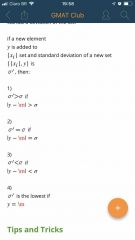![]()
![]()
![]()
Use LEFT and RIGHT arrow keys to navigate between flashcards;
Use UP and DOWN arrow keys to flip the card;
H to show hint;
A reads text to speech;
5 Cards in this Set
- Front
- Back
|
If you increase the range does the standard deviation also increase? |

Not necessarily. Remember that if you include multiples terms even if you extend the range it is possible to diminish the standard deviation. |
|
|
If you increase each term in a set by 10 will the set increase its Standard deviation? |
No, see the example below: 10 15 20 - avg deviation 5 20 25 30 - avg deviation 5 |
|
|
If you decrease the value of each term in a set by 10%, will it decrease the standard deviation? |
Maybe. Check the examples below: 10 20 30 - avg deviation 10 9 18 27 - avg deviation 9 But if all the term are equal it will not change: 10 10 10 - avg deviation 0 9 9 9 - avg deviation 0 |
|
|
In simple words what is the standard deviation measuring? |
The standard deviation is a measure of spread. This means that if data points are close together then the SD is smaller; if the data points are very spread out, then the SD is larger. If you want to rephrase SD, try using. What is the difference between each term of the set and the mean. |
|
|
Is it possible to calculate the Standard Deviation of a set of 21 consecutive terms? |
Yes! Sum of the squared differences:10^2 + 9^2 + 8^2 + 7^2 + 6^2 + 5^2 + 4^2 + 3^2 + 2^2 + 1^2 + 0^2 + (-1)^2 + (-2)^2 + (-3)^2 + (-4)^2 + (-5)^2 + (-6)^2+ (-7)^2 + (-8^)2 + (-9)^2 + (-10)^2 = 770 Average of the sum of the squared differences: 770/21
The square root of this average is the standard deviation: ≈ 6.06 |

